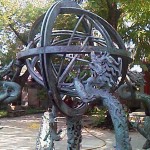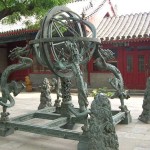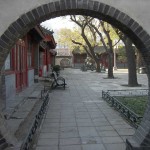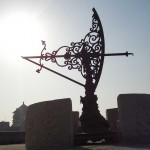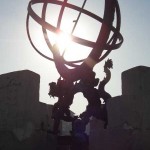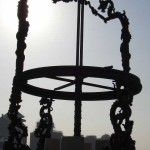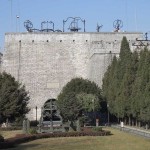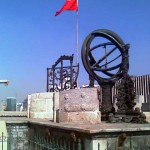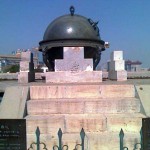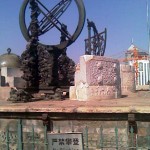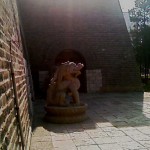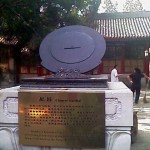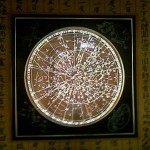My trip to the Ancient Observatory
Ancient Observatory, Beijing was known as the ‘Platform of Star Watching’ during the Ming Dynasty but later the name was changed to ‘Observatory’ during the Qing Dynasty. The name was further changed to ‘Central Observatory’ after the revolution of 1911. After its renovation in 1980, the Observatory has become the, ‘Beijing Ancient Astronomical Display Hall’. Records of astronomical observations run from 1442 to 1929, making it the record-holder for the longest period of continuous sky watching. The observatory was in use until 1929 and restored as a museum 2008(!). Today’s building stands alone, severed from the ancient Beijing city wall that Mao Zedong ordered destroyed to make way for the Second Ring Road. As a result, the observatory sits amidst a graceless jumble of modern buildings and highway overpasses, cloaked in the smog of China’s booming capital. Most would agree that the observatory has seen better days, but it still exists as an impressive and fascinating monument to the history of science in China. It can be reached by taxi and there is aclose underground station,. I directed the cab driver to the ancient observatory east of Tiananmen Square using a printout of the official web page in Chinese with the phone number because my Chinese is limited (non existent). Even then he had trouble to find the entry although from the avenue below, some of the various archaic instruments are clearly visible in the skyline.
This ancient pre-telescopic observatory, the most important in China, was first built in 1422 during the Ming Dynasty, around the same time as the Forbidden City. Covering an area of 10, 000 square meters, the Ancient Observatory of Beijing is one of the oldest Observatories in the world, situated in the southeast corner of Beijing’s Jianguomen Bridge. With more than five hundred years old history, Ancient Observatory is not only one of the oldest but also one of the most interesting historical observatories in the world. It is recognized for magnificence, unrivalled beautiful craftsmanship and best preserved instruments, some according the design of Thycho Brahe. Muslim scholars were also recruited and in the seventeenth century, the Jesuits, who were able to more accurately predict the eclipses, helped to further develop the observations of the stars and the planets. During the Boxer Rebellion, the instruments disappeared into the hands of the French and Germans. Some were returned in 1902, and others (good guess – the German parts) were returned after WWI, under the provisions of the Treaty of Versailles (1919).
.  Thycho Brahe instruments, the work of his life, became obsolete after the invention of the telescope and got burned, but in Beijing, one can still see them. This is the story, which is full of irony. Following the advice of Jesuit padre Joseph Adam Schall von Bell, a teacher of the heir to the emperor and political advisor of the emperor, the Chinese began to use western computation and measuring systems. Another Jesuit, Ferdinand Verbiest constructed the new instruments. According to some sources, he came out of prison, because Emperor Kang Xi wanted to hear his opinion to the calendar reform, proposed by the emperor’s Muslim court astronomer. In 1669, the Kangxi Emperor was informed that serious errors had been found in the calendar for 1670, which had been drawn up by Yang Guangxian. Kangxi commanded a public test to compare the merits of European and Chinese astronomy. The Jesuit, could outwit his competitor.
Thycho Brahe instruments, the work of his life, became obsolete after the invention of the telescope and got burned, but in Beijing, one can still see them. This is the story, which is full of irony. Following the advice of Jesuit padre Joseph Adam Schall von Bell, a teacher of the heir to the emperor and political advisor of the emperor, the Chinese began to use western computation and measuring systems. Another Jesuit, Ferdinand Verbiest constructed the new instruments. According to some sources, he came out of prison, because Emperor Kang Xi wanted to hear his opinion to the calendar reform, proposed by the emperor’s Muslim court astronomer. In 1669, the Kangxi Emperor was informed that serious errors had been found in the calendar for 1670, which had been drawn up by Yang Guangxian. Kangxi commanded a public test to compare the merits of European and Chinese astronomy. The Jesuit, could outwit his competitor.  The test was to predict three things: the length of the shadow thrown by a gnomon of a given height at noon of a certain day; the absolute and relative positions of the sun and the planets on a given date; and the exact time of an anticipated lunar eclipse. Verbiest had access to the latest updates on the Rudolphine Tables, done by Kepler with the inherited observations of Thycho Brahe. Ferdinand Verbiest succeeded therefore in all three tests, and was immediately installed as Head of the Mathematical Board and Director of the Observatory. Out of consideration for him, the exiled Jesuits were authorized to return to their missions. The old court astronomer was deposed, and Ferdinand Verbiest became responsible for calendar reform and this court observatory, which he remodelled then with European instruments.
The test was to predict three things: the length of the shadow thrown by a gnomon of a given height at noon of a certain day; the absolute and relative positions of the sun and the planets on a given date; and the exact time of an anticipated lunar eclipse. Verbiest had access to the latest updates on the Rudolphine Tables, done by Kepler with the inherited observations of Thycho Brahe. Ferdinand Verbiest succeeded therefore in all three tests, and was immediately installed as Head of the Mathematical Board and Director of the Observatory. Out of consideration for him, the exiled Jesuits were authorized to return to their missions. The old court astronomer was deposed, and Ferdinand Verbiest became responsible for calendar reform and this court observatory, which he remodelled then with European instruments.
Having resolved the issues surrounding the calendar, Verbiest went on to compose a table of all solar and lunar eclipses for the next 2000 years. Delighted with this, the emperor awarded him complete charge of the imperial astronomy observatory, which he rebuilt in 1673. The existing equipment was obsolete, so Verbiest consigned it to a museum and set about designing six new instruments, later, Kilian Stumpf designed other instruments, the new Armilla and the Azimuth Theodilite.
- Altazimuth, used to measure the position of celestial bodies relative to the celestial horizon and the zenith – the altitude azimuth.
- Celestial globe, six feet in diameter, used to map and identify celestial objects.
- Ecliptic armilla, armillary sphere, six feet in diameter, used to measure the ecliptic longitude difference and latitudes of celestial bodies. (This was the traditional European device while the Chinese developed the equatorial armilla.)
- Equatorial armilla, armillary sphere, six feet in diameter, used primarily for measuring true solar time as well as right ascension difference and declination of celestial bodies.
- Quadrant Altazimuth, six feet in radius, for measuring altitudes or zenith distances of celestial bodies.
- Sextant, eight feet in radius, used to measure the angle of elevation of a celestial object above the horizon. It is used to calculate the angle between two objects, although it is limited to 60 degrees of arc. In navigation, it is used to take a measure of the angle of the sun at noon to determine latitude.
The flat top, 14 meters (46 feet) high, is home to an amazing array of instruments, some originals and others replicas. Among the most interesting are those that were constructed under the direction of Jesuit astronomers residing in Beijing at the invitation of Qing emperors; designed to Western specifications with superficial Chinese ornamentation, the bronze instruments are examples of the first wave of modern-era scientific collaboration between China and the West. On entering the unassuming entrance of the observatory compound, one can see various sea-faring instruments at the courtyard, including an interesting sundial. In the courtyard of the museum, surrounded by ancient trees, the hall and east gate areas exhibit early astronomical instruments and the methods and changes in making them. In the western chamber some 150 early methods of calculating calendars in China are exhibited. Eight bronze astronomical instruments are arranged on the top of the platform, as per the Qing-dynasty emperor Qianlong’s instructions. One then enters a two storey museum which is a collection of pictures, write-ups and busts to show the ancient Chinese scientists and their various astronomical achievements and a replica of a Ming Dynasty gold foil map of the constellations. On climbing to the roof of the observatory, one is almost alone with those unique giant bronze instruments designed in the Qing Dynasty the celestial globe, dragon quadrant, elliptical armillary and azimuth theodolite by the Jesuits. With the completion of the present observatory, it has housed the replica instruments and served the Ming and Qing astronomers in their star-gazing reports, for the Emperor, the Son of Heaven, is closely tied up with the movements of the heavenly bodies. Considered as a milestone in Chinese architecture, Ancient Observatory, Beijing marks my cultural crossroads between the Orient I admire and the Western Catholizism roots which I admire in my way too (when it is lively, intellectual and strong).


